Essay on Corporate Integrated Reporting: MPA 701 Accounting
VerifiedAdded on 2023/06/12
|7
|1819
|459
Essay
AI Summary
This essay provides a detailed analysis of corporate integrated reporting (CIR) and its significance in modern financial practices. It emphasizes how CIR enhances the quality and accessibility of financial information for stakeholders, promoting better accountability and decision-making. The essay explores the objectives of CIR, including providing quality financial statements, improving accountability, ensuring consistency in financial statement comparison, aiding decision-making, incorporating non-financial reporting, assessing risks, and facilitating capital formation. It also highlights the importance of integrating financial and non-financial data to provide a holistic view of a company's performance and sustainability. The conclusion advocates for the adoption of CIR to improve financial reporting systems and benefit society as a whole.
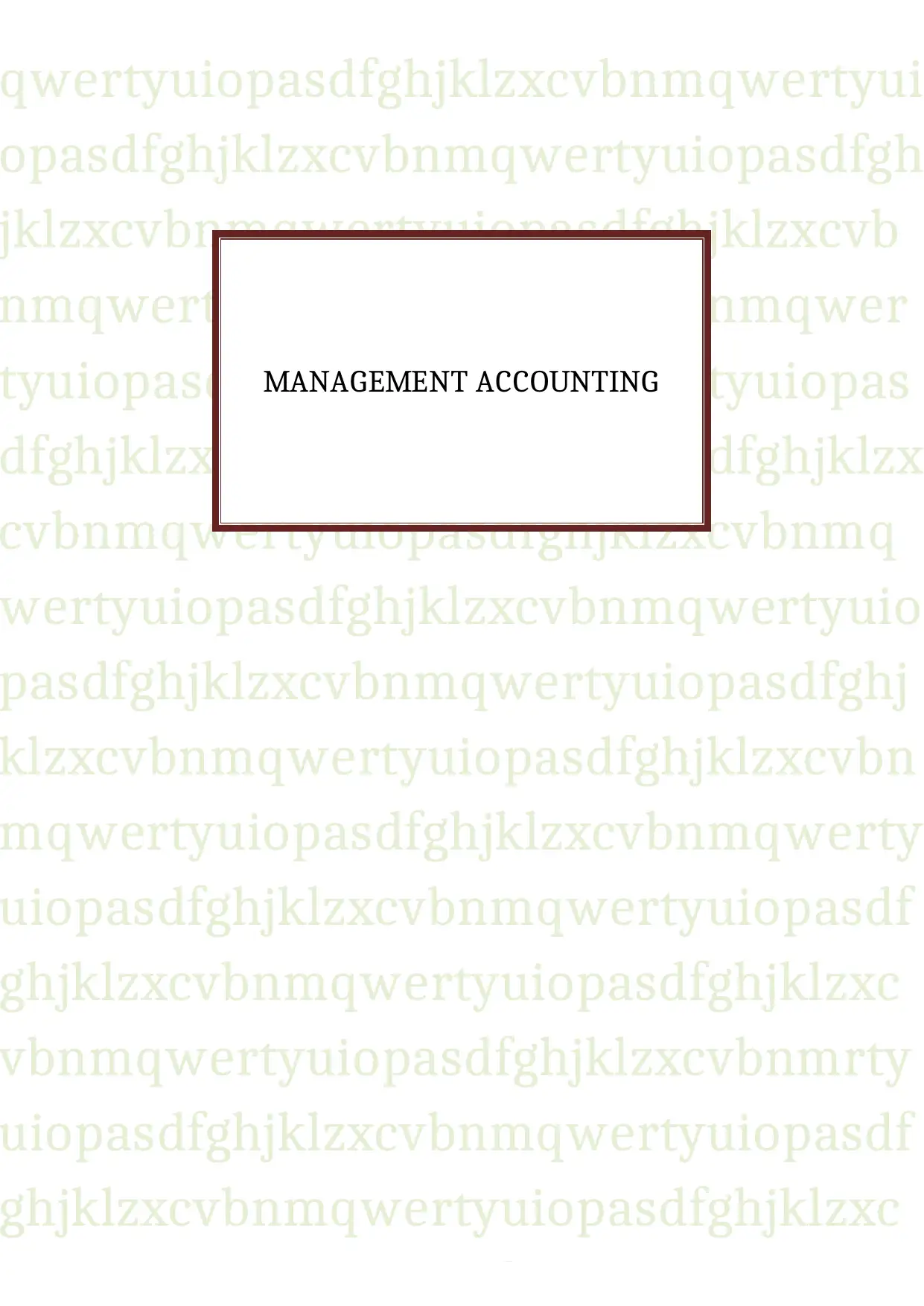
qwertyuiopasdfghjklzxcvbnmqwertyui
opasdfghjklzxcvbnmqwertyuiopasdfgh
jklzxcvbnmqwertyuiopasdfghjklzxcvb
nmqwertyuiopasdfghjklzxcvbnmqwer
tyuiopasdfghjklzxcvbnmqwertyuiopas
dfghjklzxcvbnmqwertyuiopasdfghjklzx
cvbnmqwertyuiopasdfghjklzxcvbnmq
wertyuiopasdfghjklzxcvbnmqwertyuio
pasdfghjklzxcvbnmqwertyuiopasdfghj
klzxcvbnmqwertyuiopasdfghjklzxcvbn
mqwertyuiopasdfghjklzxcvbnmqwerty
uiopasdfghjklzxcvbnmqwertyuiopasdf
ghjklzxcvbnmqwertyuiopasdfghjklzxc
vbnmqwertyuiopasdfghjklzxcvbnmrty
uiopasdfghjklzxcvbnmqwertyuiopasdf
ghjklzxcvbnmqwertyuiopasdfghjklzxc
vbnmqwertyuiopasdfghjklzxcvbnmqw
MANAGEMENT ACCOUNTING
opasdfghjklzxcvbnmqwertyuiopasdfgh
jklzxcvbnmqwertyuiopasdfghjklzxcvb
nmqwertyuiopasdfghjklzxcvbnmqwer
tyuiopasdfghjklzxcvbnmqwertyuiopas
dfghjklzxcvbnmqwertyuiopasdfghjklzx
cvbnmqwertyuiopasdfghjklzxcvbnmq
wertyuiopasdfghjklzxcvbnmqwertyuio
pasdfghjklzxcvbnmqwertyuiopasdfghj
klzxcvbnmqwertyuiopasdfghjklzxcvbn
mqwertyuiopasdfghjklzxcvbnmqwerty
uiopasdfghjklzxcvbnmqwertyuiopasdf
ghjklzxcvbnmqwertyuiopasdfghjklzxc
vbnmqwertyuiopasdfghjklzxcvbnmrty
uiopasdfghjklzxcvbnmqwertyuiopasdf
ghjklzxcvbnmqwertyuiopasdfghjklzxc
vbnmqwertyuiopasdfghjklzxcvbnmqw
MANAGEMENT ACCOUNTING
Paraphrase This Document
Need a fresh take? Get an instant paraphrase of this document with our AI Paraphraser
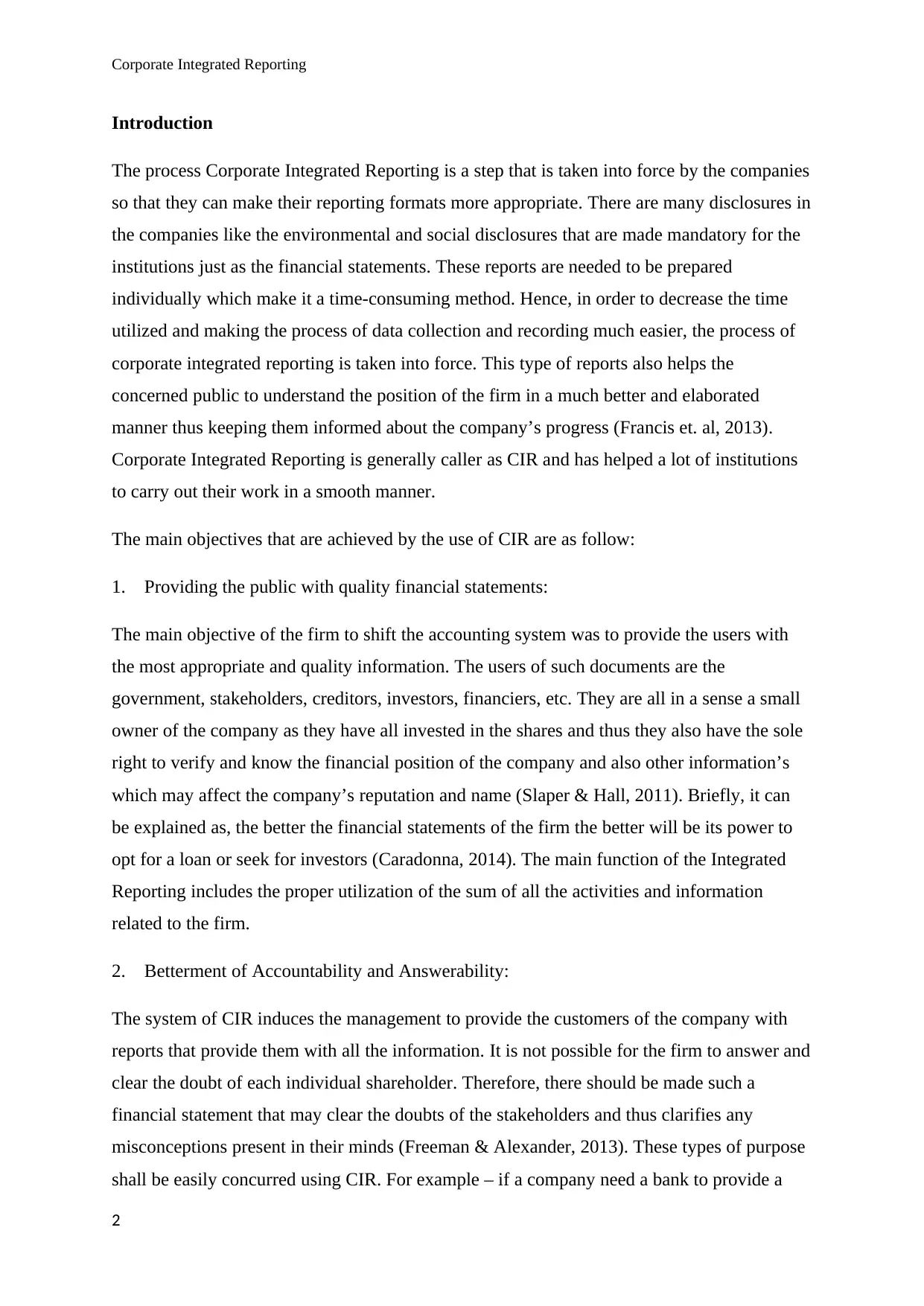
Corporate Integrated Reporting
Introduction
The process Corporate Integrated Reporting is a step that is taken into force by the companies
so that they can make their reporting formats more appropriate. There are many disclosures in
the companies like the environmental and social disclosures that are made mandatory for the
institutions just as the financial statements. These reports are needed to be prepared
individually which make it a time-consuming method. Hence, in order to decrease the time
utilized and making the process of data collection and recording much easier, the process of
corporate integrated reporting is taken into force. This type of reports also helps the
concerned public to understand the position of the firm in a much better and elaborated
manner thus keeping them informed about the company’s progress (Francis et. al, 2013).
Corporate Integrated Reporting is generally caller as CIR and has helped a lot of institutions
to carry out their work in a smooth manner.
The main objectives that are achieved by the use of CIR are as follow:
1. Providing the public with quality financial statements:
The main objective of the firm to shift the accounting system was to provide the users with
the most appropriate and quality information. The users of such documents are the
government, stakeholders, creditors, investors, financiers, etc. They are all in a sense a small
owner of the company as they have all invested in the shares and thus they also have the sole
right to verify and know the financial position of the company and also other information’s
which may affect the company’s reputation and name (Slaper & Hall, 2011). Briefly, it can
be explained as, the better the financial statements of the firm the better will be its power to
opt for a loan or seek for investors (Caradonna, 2014). The main function of the Integrated
Reporting includes the proper utilization of the sum of all the activities and information
related to the firm.
2. Betterment of Accountability and Answerability:
The system of CIR induces the management to provide the customers of the company with
reports that provide them with all the information. It is not possible for the firm to answer and
clear the doubt of each individual shareholder. Therefore, there should be made such a
financial statement that may clear the doubts of the stakeholders and thus clarifies any
misconceptions present in their minds (Freeman & Alexander, 2013). These types of purpose
shall be easily concurred using CIR. For example – if a company need a bank to provide a
2
Introduction
The process Corporate Integrated Reporting is a step that is taken into force by the companies
so that they can make their reporting formats more appropriate. There are many disclosures in
the companies like the environmental and social disclosures that are made mandatory for the
institutions just as the financial statements. These reports are needed to be prepared
individually which make it a time-consuming method. Hence, in order to decrease the time
utilized and making the process of data collection and recording much easier, the process of
corporate integrated reporting is taken into force. This type of reports also helps the
concerned public to understand the position of the firm in a much better and elaborated
manner thus keeping them informed about the company’s progress (Francis et. al, 2013).
Corporate Integrated Reporting is generally caller as CIR and has helped a lot of institutions
to carry out their work in a smooth manner.
The main objectives that are achieved by the use of CIR are as follow:
1. Providing the public with quality financial statements:
The main objective of the firm to shift the accounting system was to provide the users with
the most appropriate and quality information. The users of such documents are the
government, stakeholders, creditors, investors, financiers, etc. They are all in a sense a small
owner of the company as they have all invested in the shares and thus they also have the sole
right to verify and know the financial position of the company and also other information’s
which may affect the company’s reputation and name (Slaper & Hall, 2011). Briefly, it can
be explained as, the better the financial statements of the firm the better will be its power to
opt for a loan or seek for investors (Caradonna, 2014). The main function of the Integrated
Reporting includes the proper utilization of the sum of all the activities and information
related to the firm.
2. Betterment of Accountability and Answerability:
The system of CIR induces the management to provide the customers of the company with
reports that provide them with all the information. It is not possible for the firm to answer and
clear the doubt of each individual shareholder. Therefore, there should be made such a
financial statement that may clear the doubts of the stakeholders and thus clarifies any
misconceptions present in their minds (Freeman & Alexander, 2013). These types of purpose
shall be easily concurred using CIR. For example – if a company need a bank to provide a
2
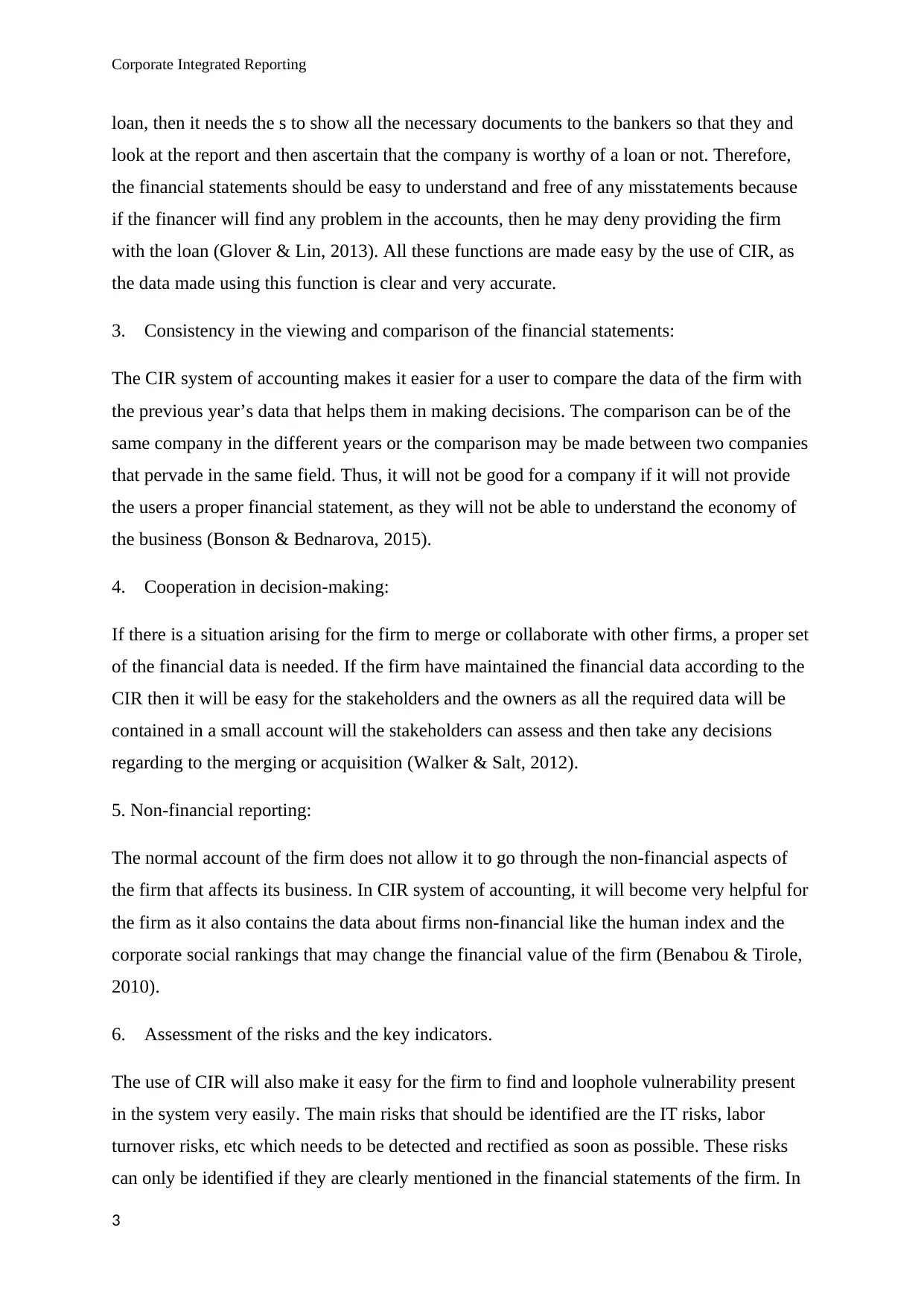
Corporate Integrated Reporting
loan, then it needs the s to show all the necessary documents to the bankers so that they and
look at the report and then ascertain that the company is worthy of a loan or not. Therefore,
the financial statements should be easy to understand and free of any misstatements because
if the financer will find any problem in the accounts, then he may deny providing the firm
with the loan (Glover & Lin, 2013). All these functions are made easy by the use of CIR, as
the data made using this function is clear and very accurate.
3. Consistency in the viewing and comparison of the financial statements:
The CIR system of accounting makes it easier for a user to compare the data of the firm with
the previous year’s data that helps them in making decisions. The comparison can be of the
same company in the different years or the comparison may be made between two companies
that pervade in the same field. Thus, it will not be good for a company if it will not provide
the users a proper financial statement, as they will not be able to understand the economy of
the business (Bonson & Bednarova, 2015).
4. Cooperation in decision-making:
If there is a situation arising for the firm to merge or collaborate with other firms, a proper set
of the financial data is needed. If the firm have maintained the financial data according to the
CIR then it will be easy for the stakeholders and the owners as all the required data will be
contained in a small account will the stakeholders can assess and then take any decisions
regarding to the merging or acquisition (Walker & Salt, 2012).
5. Non-financial reporting:
The normal account of the firm does not allow it to go through the non-financial aspects of
the firm that affects its business. In CIR system of accounting, it will become very helpful for
the firm as it also contains the data about firms non-financial like the human index and the
corporate social rankings that may change the financial value of the firm (Benabou & Tirole,
2010).
6. Assessment of the risks and the key indicators.
The use of CIR will also make it easy for the firm to find and loophole vulnerability present
in the system very easily. The main risks that should be identified are the IT risks, labor
turnover risks, etc which needs to be detected and rectified as soon as possible. These risks
can only be identified if they are clearly mentioned in the financial statements of the firm. In
3
loan, then it needs the s to show all the necessary documents to the bankers so that they and
look at the report and then ascertain that the company is worthy of a loan or not. Therefore,
the financial statements should be easy to understand and free of any misstatements because
if the financer will find any problem in the accounts, then he may deny providing the firm
with the loan (Glover & Lin, 2013). All these functions are made easy by the use of CIR, as
the data made using this function is clear and very accurate.
3. Consistency in the viewing and comparison of the financial statements:
The CIR system of accounting makes it easier for a user to compare the data of the firm with
the previous year’s data that helps them in making decisions. The comparison can be of the
same company in the different years or the comparison may be made between two companies
that pervade in the same field. Thus, it will not be good for a company if it will not provide
the users a proper financial statement, as they will not be able to understand the economy of
the business (Bonson & Bednarova, 2015).
4. Cooperation in decision-making:
If there is a situation arising for the firm to merge or collaborate with other firms, a proper set
of the financial data is needed. If the firm have maintained the financial data according to the
CIR then it will be easy for the stakeholders and the owners as all the required data will be
contained in a small account will the stakeholders can assess and then take any decisions
regarding to the merging or acquisition (Walker & Salt, 2012).
5. Non-financial reporting:
The normal account of the firm does not allow it to go through the non-financial aspects of
the firm that affects its business. In CIR system of accounting, it will become very helpful for
the firm as it also contains the data about firms non-financial like the human index and the
corporate social rankings that may change the financial value of the firm (Benabou & Tirole,
2010).
6. Assessment of the risks and the key indicators.
The use of CIR will also make it easy for the firm to find and loophole vulnerability present
in the system very easily. The main risks that should be identified are the IT risks, labor
turnover risks, etc which needs to be detected and rectified as soon as possible. These risks
can only be identified if they are clearly mentioned in the financial statements of the firm. In
3
⊘ This is a preview!⊘
Do you want full access?
Subscribe today to unlock all pages.

Trusted by 1+ million students worldwide
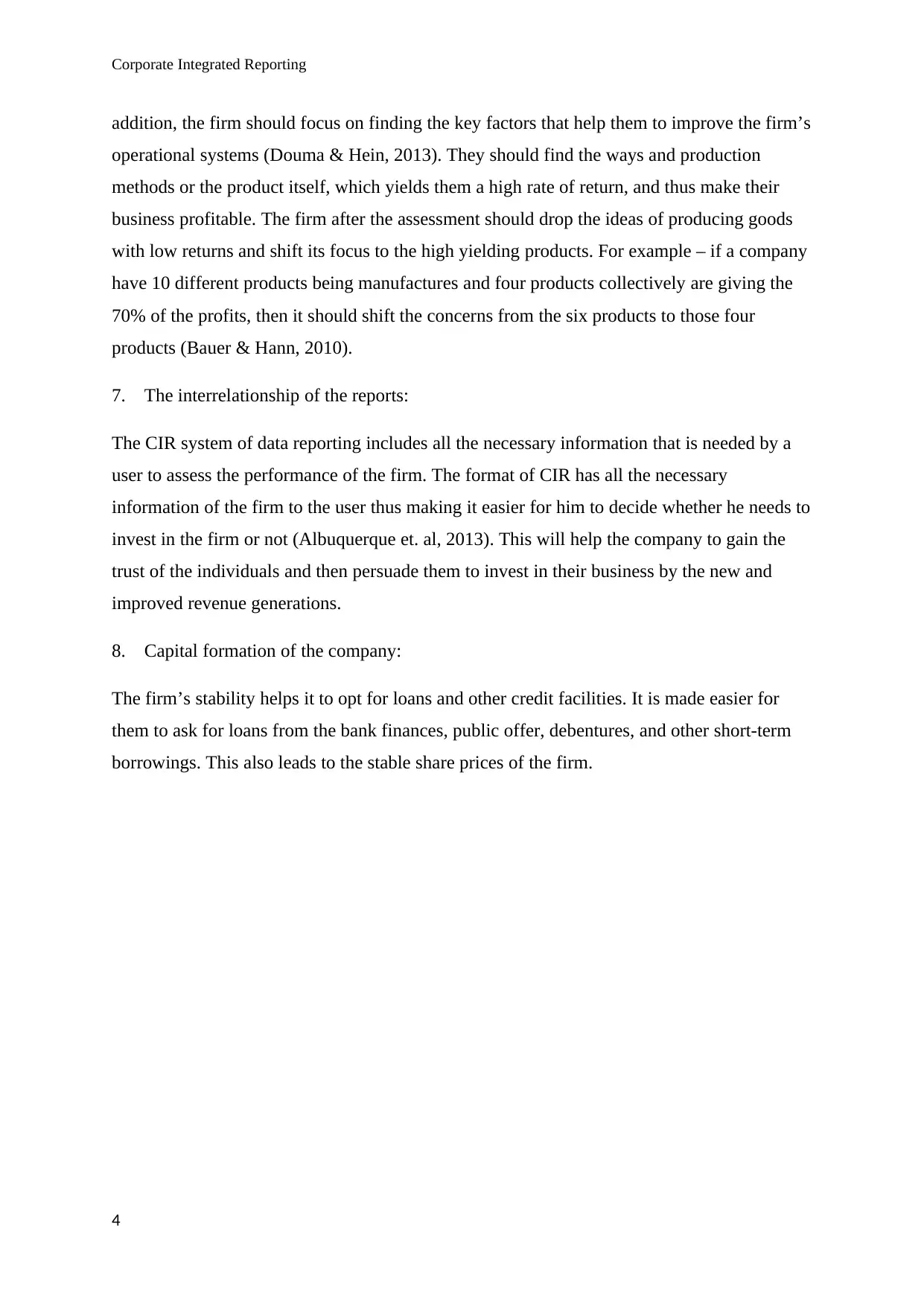
Corporate Integrated Reporting
addition, the firm should focus on finding the key factors that help them to improve the firm’s
operational systems (Douma & Hein, 2013). They should find the ways and production
methods or the product itself, which yields them a high rate of return, and thus make their
business profitable. The firm after the assessment should drop the ideas of producing goods
with low returns and shift its focus to the high yielding products. For example – if a company
have 10 different products being manufactures and four products collectively are giving the
70% of the profits, then it should shift the concerns from the six products to those four
products (Bauer & Hann, 2010).
7. The interrelationship of the reports:
The CIR system of data reporting includes all the necessary information that is needed by a
user to assess the performance of the firm. The format of CIR has all the necessary
information of the firm to the user thus making it easier for him to decide whether he needs to
invest in the firm or not (Albuquerque et. al, 2013). This will help the company to gain the
trust of the individuals and then persuade them to invest in their business by the new and
improved revenue generations.
8. Capital formation of the company:
The firm’s stability helps it to opt for loans and other credit facilities. It is made easier for
them to ask for loans from the bank finances, public offer, debentures, and other short-term
borrowings. This also leads to the stable share prices of the firm.
4
addition, the firm should focus on finding the key factors that help them to improve the firm’s
operational systems (Douma & Hein, 2013). They should find the ways and production
methods or the product itself, which yields them a high rate of return, and thus make their
business profitable. The firm after the assessment should drop the ideas of producing goods
with low returns and shift its focus to the high yielding products. For example – if a company
have 10 different products being manufactures and four products collectively are giving the
70% of the profits, then it should shift the concerns from the six products to those four
products (Bauer & Hann, 2010).
7. The interrelationship of the reports:
The CIR system of data reporting includes all the necessary information that is needed by a
user to assess the performance of the firm. The format of CIR has all the necessary
information of the firm to the user thus making it easier for him to decide whether he needs to
invest in the firm or not (Albuquerque et. al, 2013). This will help the company to gain the
trust of the individuals and then persuade them to invest in their business by the new and
improved revenue generations.
8. Capital formation of the company:
The firm’s stability helps it to opt for loans and other credit facilities. It is made easier for
them to ask for loans from the bank finances, public offer, debentures, and other short-term
borrowings. This also leads to the stable share prices of the firm.
4
Paraphrase This Document
Need a fresh take? Get an instant paraphrase of this document with our AI Paraphraser
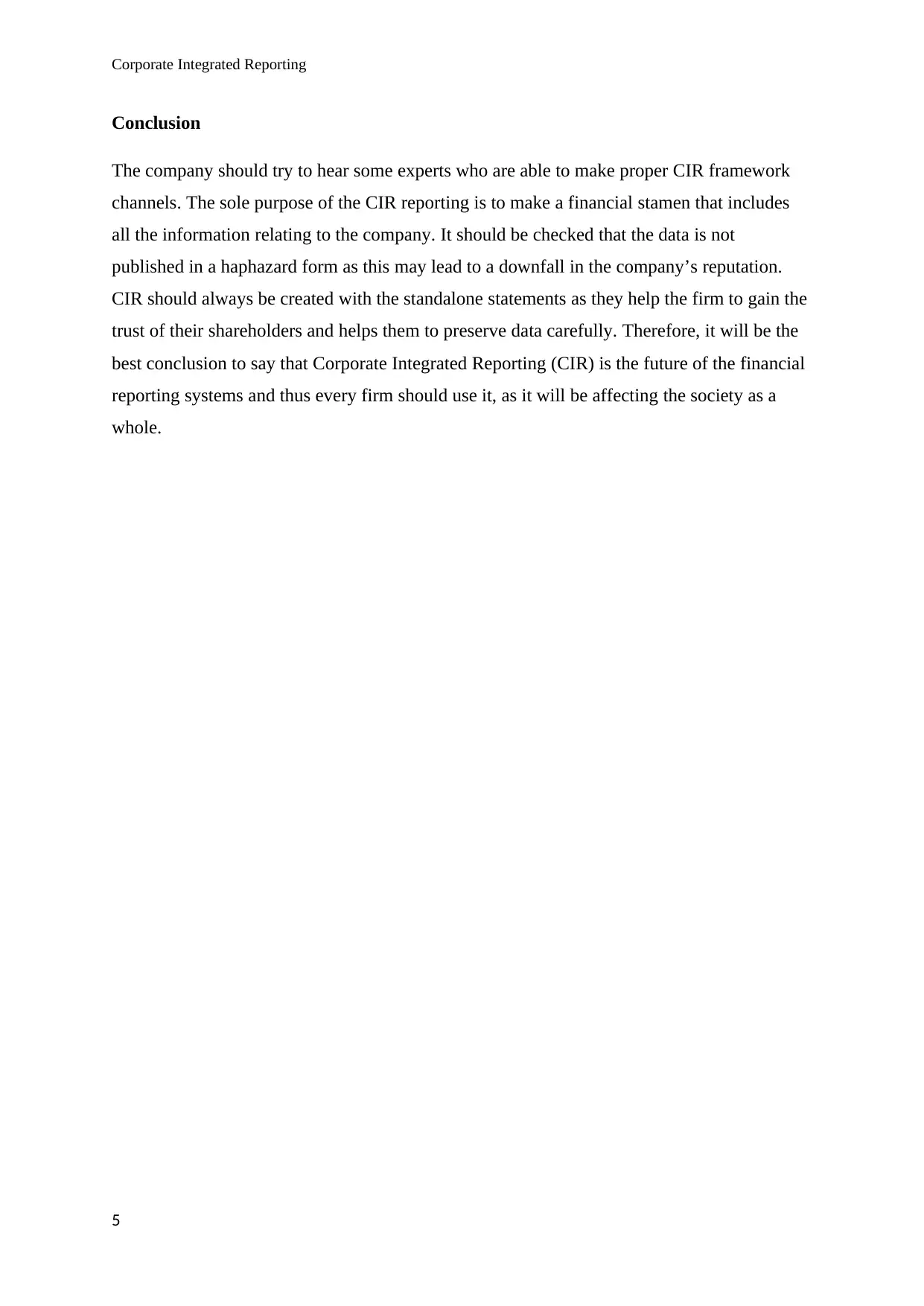
Corporate Integrated Reporting
Conclusion
The company should try to hear some experts who are able to make proper CIR framework
channels. The sole purpose of the CIR reporting is to make a financial stamen that includes
all the information relating to the company. It should be checked that the data is not
published in a haphazard form as this may lead to a downfall in the company’s reputation.
CIR should always be created with the standalone statements as they help the firm to gain the
trust of their shareholders and helps them to preserve data carefully. Therefore, it will be the
best conclusion to say that Corporate Integrated Reporting (CIR) is the future of the financial
reporting systems and thus every firm should use it, as it will be affecting the society as a
whole.
5
Conclusion
The company should try to hear some experts who are able to make proper CIR framework
channels. The sole purpose of the CIR reporting is to make a financial stamen that includes
all the information relating to the company. It should be checked that the data is not
published in a haphazard form as this may lead to a downfall in the company’s reputation.
CIR should always be created with the standalone statements as they help the firm to gain the
trust of their shareholders and helps them to preserve data carefully. Therefore, it will be the
best conclusion to say that Corporate Integrated Reporting (CIR) is the future of the financial
reporting systems and thus every firm should use it, as it will be affecting the society as a
whole.
5
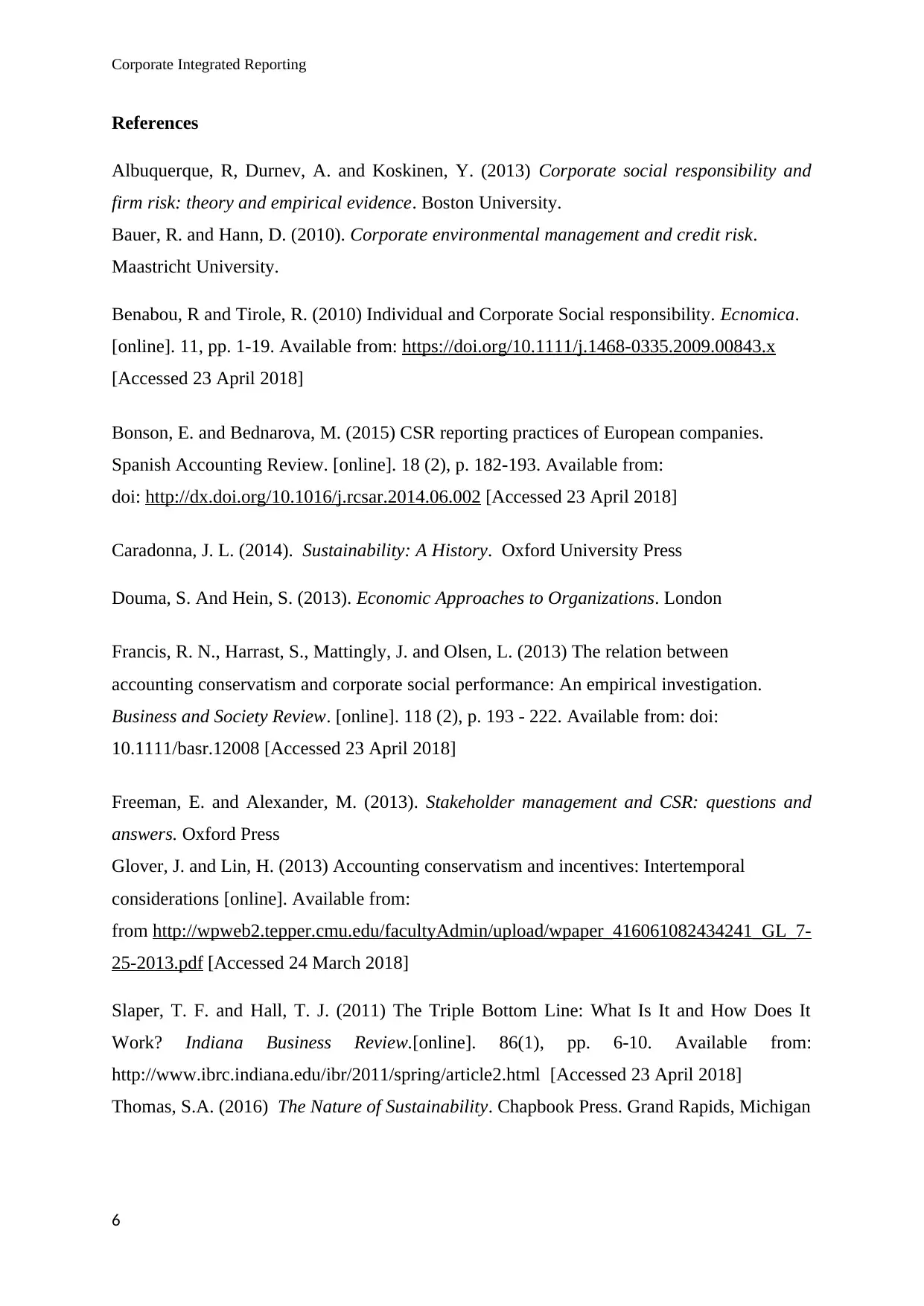
Corporate Integrated Reporting
References
Albuquerque, R, Durnev, A. and Koskinen, Y. (2013) Corporate social responsibility and
firm risk: theory and empirical evidence. Boston University.
Bauer, R. and Hann, D. (2010). Corporate environmental management and credit risk.
Maastricht University.
Benabou, R and Tirole, R. (2010) Individual and Corporate Social responsibility. Ecnomica.
[online]. 11, pp. 1-19. Available from: https://doi.org/10.1111/j.1468-0335.2009.00843.x
[Accessed 23 April 2018]
Bonson, E. and Bednarova, M. (2015) CSR reporting practices of European companies.
Spanish Accounting Review. [online]. 18 (2), p. 182-193. Available from:
doi: http://dx.doi.org/10.1016/j.rcsar.2014.06.002 [Accessed 23 April 2018]
Caradonna, J. L. (2014). Sustainability: A History. Oxford University Press
Douma, S. And Hein, S. (2013). Economic Approaches to Organizations. London
Francis, R. N., Harrast, S., Mattingly, J. and Olsen, L. (2013) The relation between
accounting conservatism and corporate social performance: An empirical investigation.
Business and Society Review. [online]. 118 (2), p. 193 - 222. Available from: doi:
10.1111/basr.12008 [Accessed 23 April 2018]
Freeman, E. and Alexander, M. (2013). Stakeholder management and CSR: questions and
answers. Oxford Press
Glover, J. and Lin, H. (2013) Accounting conservatism and incentives: Intertemporal
considerations [online]. Available from:
from http://wpweb2.tepper.cmu.edu/facultyAdmin/upload/wpaper_416061082434241_GL_7-
25-2013.pdf [Accessed 24 March 2018]
Slaper, T. F. and Hall, T. J. (2011) The Triple Bottom Line: What Is It and How Does It
Work? Indiana Business Review.[online]. 86(1), pp. 6-10. Available from:
http://www.ibrc.indiana.edu/ibr/2011/spring/article2.html [Accessed 23 April 2018]
Thomas, S.A. (2016) The Nature of Sustainability. Chapbook Press. Grand Rapids, Michigan
6
References
Albuquerque, R, Durnev, A. and Koskinen, Y. (2013) Corporate social responsibility and
firm risk: theory and empirical evidence. Boston University.
Bauer, R. and Hann, D. (2010). Corporate environmental management and credit risk.
Maastricht University.
Benabou, R and Tirole, R. (2010) Individual and Corporate Social responsibility. Ecnomica.
[online]. 11, pp. 1-19. Available from: https://doi.org/10.1111/j.1468-0335.2009.00843.x
[Accessed 23 April 2018]
Bonson, E. and Bednarova, M. (2015) CSR reporting practices of European companies.
Spanish Accounting Review. [online]. 18 (2), p. 182-193. Available from:
doi: http://dx.doi.org/10.1016/j.rcsar.2014.06.002 [Accessed 23 April 2018]
Caradonna, J. L. (2014). Sustainability: A History. Oxford University Press
Douma, S. And Hein, S. (2013). Economic Approaches to Organizations. London
Francis, R. N., Harrast, S., Mattingly, J. and Olsen, L. (2013) The relation between
accounting conservatism and corporate social performance: An empirical investigation.
Business and Society Review. [online]. 118 (2), p. 193 - 222. Available from: doi:
10.1111/basr.12008 [Accessed 23 April 2018]
Freeman, E. and Alexander, M. (2013). Stakeholder management and CSR: questions and
answers. Oxford Press
Glover, J. and Lin, H. (2013) Accounting conservatism and incentives: Intertemporal
considerations [online]. Available from:
from http://wpweb2.tepper.cmu.edu/facultyAdmin/upload/wpaper_416061082434241_GL_7-
25-2013.pdf [Accessed 24 March 2018]
Slaper, T. F. and Hall, T. J. (2011) The Triple Bottom Line: What Is It and How Does It
Work? Indiana Business Review.[online]. 86(1), pp. 6-10. Available from:
http://www.ibrc.indiana.edu/ibr/2011/spring/article2.html [Accessed 23 April 2018]
Thomas, S.A. (2016) The Nature of Sustainability. Chapbook Press. Grand Rapids, Michigan
6
⊘ This is a preview!⊘
Do you want full access?
Subscribe today to unlock all pages.

Trusted by 1+ million students worldwide
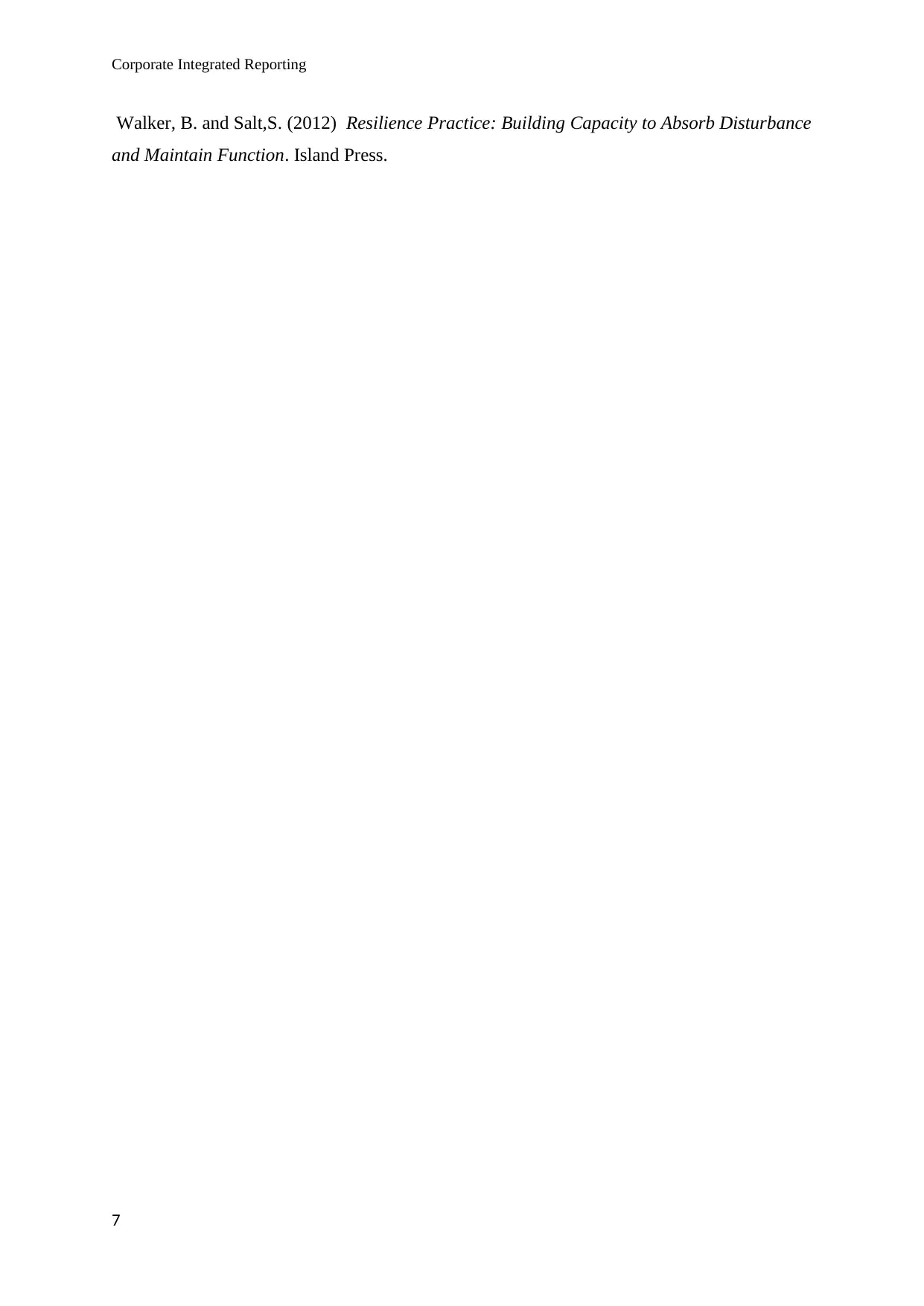
Corporate Integrated Reporting
Walker, B. and Salt,S. (2012) Resilience Practice: Building Capacity to Absorb Disturbance
and Maintain Function. Island Press.
7
Walker, B. and Salt,S. (2012) Resilience Practice: Building Capacity to Absorb Disturbance
and Maintain Function. Island Press.
7
1 out of 7
Related Documents
Your All-in-One AI-Powered Toolkit for Academic Success.
+13062052269
info@desklib.com
Available 24*7 on WhatsApp / Email
![[object Object]](/_next/static/media/star-bottom.7253800d.svg)
Unlock your academic potential
Copyright © 2020–2025 A2Z Services. All Rights Reserved. Developed and managed by ZUCOL.


